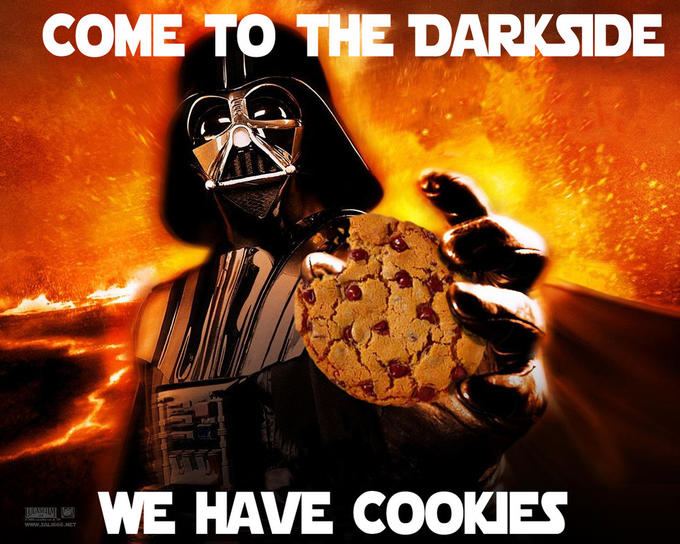One of the most important parts of your novel is your characters. They are the part readers relate to. They are the ones that make things happen. Without them, there wouldn’t be a story.
Because characters are so important, I’m going to share with you my sage wisdom on creating characters and introducing them in your story.
Yes, I am the Yoda of character creation. Listen to my wise words.

And while you’re at it, bring me some cookies. Ehem…I mean…me some cookies you will bring. (Feel that force compelling you?)
Oh, I forgot. All the cookies are on the dark side.

Okay, enough with Star Wars. Let’s get down to business. (Did anyone else just see Mulan? 😀 )
Because characters are so important and because there is so much to think about when creating them and introducing them to readers, I’ve made this a five-post thing. We’ll be talking about naming characters in this post, and the next topics will be Making Your Characters Come Alive (part 1 and part 2), Creating a Character Arc, and Introducing Your Characters.
Ready to create some awesome characters? Let’s get started with their name.
What’s in a name?
A name is often a reader’s first impression of a character, so choose names wisely. The name Billy Joe immediately brings to mind a country bumpkin, while the name Shannon will bring the image of a teen girl with a bubble of gum coming out of her mouth, twirling her hair and getting ready to share some juicy gossip.
Don’t name the villain something like Sam or John. That’s just anticlimactic. Voldemort, Darth Vader, Galbatorix, and Sauron all give off the feeling of being ominous. You don’t even have to be told that they are the villain. The name alone makes you go, “Hum…I don’t think this is going to be the protagonist’s best friend.”

Of course you won’t be able to tell everything from a name, but it should match your character’s personality. In The Hunger Games, Veronica Roth gives the main character’s sister the name Primrose. It’s sweet, gentle, and delicate just like the character herself (at least at the beginning). You can make a character’s name an obvious correlation between them and what they do like Roth did by naming a baker Peeta. You could name your archer character Fletcher or a dragon tamer Drake (which means dragon).
Or you can use their name to hide their true nature…
Hiding Your Character’s Nature
You may want your character’s true nature to be hidden, and in that case would name them according to whatever nature they presented. So maybe you’re writing a mystery and you want one of the suspects to seem as innocent as possible, even if they are guilty. Or maybe you want have the main character’s best friend to be working with the enemy behind their back the whole time. In this case, you wouldn’t want the name to make them sound like the “bad guy.” If the best friend’s name is Darth Sarumort, readers may suspect something. 😉 Give these characters names that make them seem more innocent than the really are to misdirect suspicion.

Changing Names
Occasionally, your character will have a reason to change their name. Maybe they are undercover and their real name is only revealed once their true identity comes out. Or maybe their name changes to symbolize growth or a moment of decision.
Roth does this in Divergent. At the beginning of the story, the main character is known as Beatrice. It fits with her life in Abnegation and the role she plays there. But once she decides she doesn’t want to be the quiet, submissive server the rest of the people around her are and makes her stand as a Dauntless, her name becomes Tris.
“Beatrice was a girl I saw in stolen moments at the mirror, who kept quiet at the dinner table. This is someone whose eyes claim mine and don’t release me; this is Tris.“— Tris Prior, in Divergent.
You can imagine someone named Tris in hand-to-hand combat or jumping trains. Beatrice? She stays at home and knits sweaters.

If you do choose to give your character a new name, it’s helpful if the name changing is done early on in the story. Once a character becomes X in reader’s minds, it is difficult for them to switch. Unlike a movie where there is a visual representation of the character, all they have to link the image in their mind to the character is their name. If they go three fourths of the way thinking of the character as Samantha then you changed it to Rachael, it will be hard for them to connect this new name with the character.
Another way to make sure this doesn’t happen is by making the new name somewhat similar to the old name. Tris sounds like the end of Beatrice. Alison Goodman does this in her book Eon. The main character is a girl who must pretend to be a boy. Her real name is Eona. Simply drop the “a” and you have her boy name, Eon. This keeps readers from being confused or having trouble connecting either of the names to the character.

Quick recap:
When naming characters, think about their personality and make sure their name fits.
If you are hiding your characters identity, give them a name that will make them seem the opposite of what they really are.
If they make a major decision that transforms them in the story, then you may chose to give them a name switch to emphasize their change.
That’s not too hard is it?
Naming character is one of my favorite parts of writing a story, and one of the easiest. I’ve found baby naming sites like babycenter.com that let you search by starting letter, origin, or meaning are super helpful for coming up with character names.
Have fun coming up with names! Once you have that, we’ll discover just what it is that makes your character come alive.
Until next time! Keep dreaming Epic Dreamers!

This is the first of a series on character creation.
Make Your Character Come Alive (Part 1)
Make Your Characters Come Alive (Part 2)
Creating a Character Arc
Introducing Your Characters



I enjoy your teaching, and I didn’t know the dark side had cookies.
Dr. Hilda Kring, my folklore professor from college, coined a term called “characternym.” It’s a fictional person whose name reveals her or his nature (the character’s name shows the character). Her example was Uriah Heep. I think her notion (and her term) complement what you have to say here. You both realize excellent work.
Now, find crackers in the shapes of animals I shall. And I hope you’re really well. Really well you are, I hope.
LikeLiked by 1 person
I’m glad you enjoyed it! Yes, unfortunately the dark side took all the cookies. 😀
What a fun term! I looked up what the name Uriah and it means “God is my light.” I’m not sure I get the connection since I remember his character being a falsely humble and turning out to be a rat. But it’s been a while since I’ve been around David Copperfield so I may not remember correctly. 😛
Enjoy your animal crackers!
LikeLike
Enjoyed every bit of this. =) I love creative writing, but writing stories with names and settings can be difficult for me. This lifted some of the weights. =)
LikeLike
Awesome! I’m so glad this helped. Keep writing and doing what you love! You’ll get better with practice. 🙂
LikeLiked by 1 person
I once wrote my characters in a story on Wattpad and named them by the ingredients I had in my kitchen. Worked really well
LikeLike
Oh my gosh, I love it! That’s so creative!
LikeLiked by 1 person